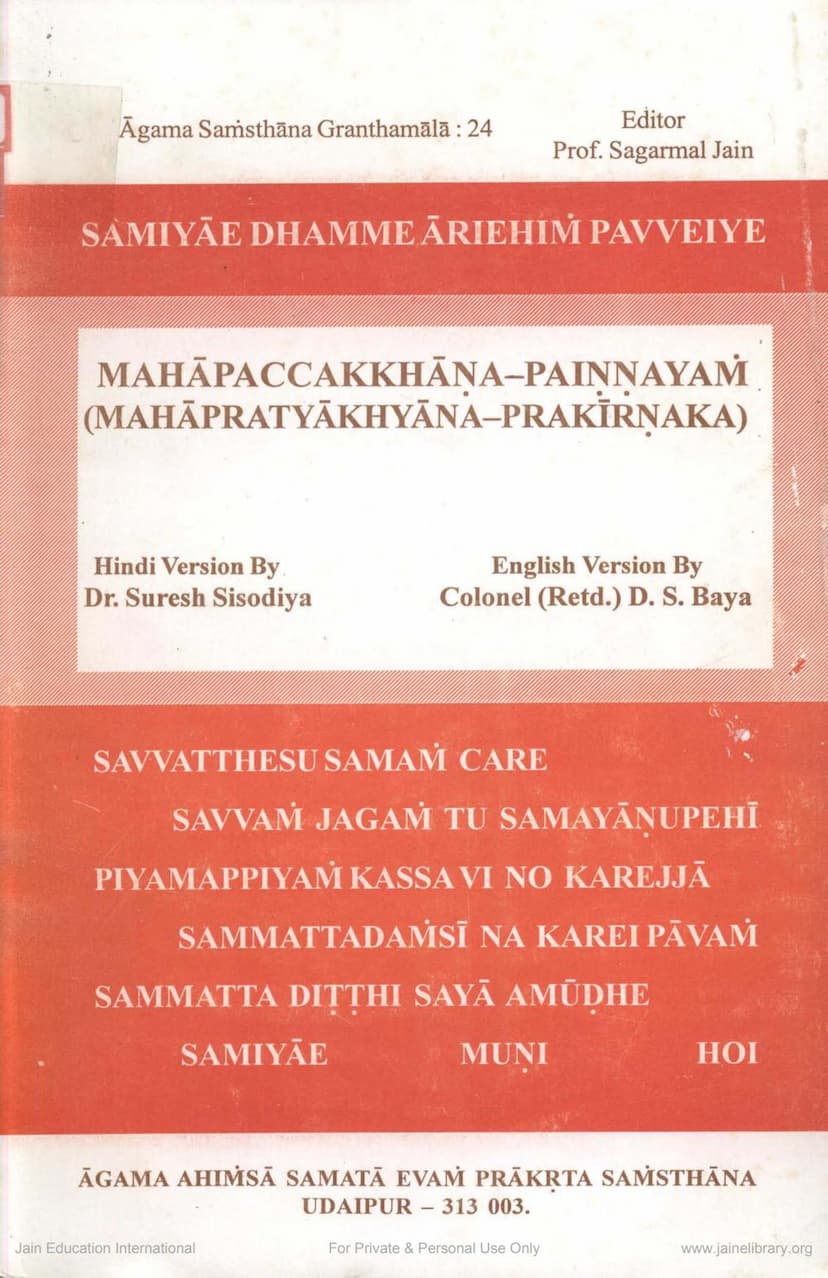Agam 26 Prakirnak 03 Maha Pacchakhana Sutra
Added to library: September 1, 2025

Summary
The Maha Pacchakkhana Sutra (also known as Mahāpratyākhyāna Prakīrṇaka) is a significant Jain text within the Prakirnaka canon, translated into English by Colonel (Retd.) D.S. Baya. This text, originating from the Ardhamāgadhi Jaina Agamic literature, focuses on the spiritual practice of Samādhimaraṇa, or voluntary peaceful death.
Here's a comprehensive summary of the key aspects covered in the provided text:
1. Context and Significance of Prakirnakas:
- The Ardhamāgadhi Jaina Agamic literature is presented as a valuable treasure of Indian culture.
- Prakirnakas are a category of canonical texts often overlooked, yet they are ancient and predominantly spiritual.
- The Agama Ahimsa Samata Evam Prakrta Samsthana in Udaipur has undertaken the task of translating these Prakirnakas into modern Indian languages and English to make them accessible.
2. Mahāpratyākhyāna Prakīrnaka - Introduction:
- The text is a poetic composition in the Prakṛta language.
- Its mention is found in ancient treatises like the Nandi Sutra and Pakshikasutra, categorizing it as an "extra-essential anytime studiable canonical text."
- The Nandi Curni and Pakshika Vrtti describe it as a text detailing the procedure for Samādhimaraṇa, the voluntary fast unto death undertaken by monks in old age or when unable to continue their monastic practices.
3. The Concept of Samādhimaraṇa:
- The text distinguishes between the practices of the Sthavira-kalpa monks (those who lived in groups) and the Jina-kalpa monks (those who practiced severe austerities independently).
- Sthavira-kalpa monks would undertake a twelve-year Sanilekhana (gradual reduction of food intake) before accepting the vow of voluntary death.
- Jina-kalpa monks would embrace Samādhimaraṇa directly when it became impossible to continue their solitary practices.
- This concept is compared to similar practices in the Digambara tradition, highlighting the universality of embracing death peacefully.
- Samādhimaraṇa is not suicide but an art of embracing death gracefully, making life and death meaningful.
4. Justification of the Name "Mahāpratyākhyāna":
- "Mahāpratyākhyāna" literally means "the greatest vow."
- Renouncing one's own body voluntarily, with mental equanimity, through fasting until death is considered the greatest renunciation and thus, the greatest vow.
- The text's focus on Samādhimaraṇa fully justifies its name.
5. Classification and Recognition of Prakīrnakas:
- The text discusses various classifications of Agamas, including Angapravista and Angabahya.
- Prakirnakas are often listed under Utkalika (anytime studiable) or Kalika (timely studiable) scriptures.
- The Nandi Sutra and Pakshikasutra place Mahāpratyākhyāna among the Utkalika texts.
- There's a discussion about the varying numbers of recognized Prakīrnakas across different Jain sects.
- The Śvetāmbara sect generally recognizes ten Prakīrnakas, while other traditions, like the Sthānakavāsī and Terapanthī, reject some of them based on perceived contradictions with core scriptural tenets.
- The text defends Prakirnakas against criticisms, arguing for contextual interpretation and highlighting the potential for misinterpretation of verses when taken out of context.
6. Author and Period of Composition:
- The author of Mahāpratyākhyāna Prakīrnaka is not explicitly mentioned in the text.
- Based on its mention in later commentaries like the Nandi Curni (7th century), it is inferred that the Mahāpratyākhyāna was composed before the 5th century AD, possibly between the 2nd and 4th centuries AD.
- The presence of its verses in ancient canonical works like the Uttaradhyayana and Niryuktis, as well as later works from both Śvetāmbara and Digambara traditions, suggests its antiquity and widespread influence.
7. Subject-Matter of Mahāpratyākhyāna Prakīrnaka: The text comprises 142 verses that cover a wide range of spiritual topics, including:
- Benediction and Salutations: Bowing to the Tirthankaras, Siddhas, and Sadhus.
- Renunciations: Various forms of renunciation (physical, mental, verbal) of attachments, desires, and worldly possessions.
- Forgiveness and Condemnation: Expressing forgiveness to all beings and condemning one's own misconduct.
- Self-Realization: Understanding the soul as the true self, separate from external possessions and relationships.
- Confession and Expiation: The importance of confessing flaws and seeking atonement from the guru.
- Virtues and Vows: Emphasis on observing the five great vows (Mahavratas) and other virtues.
- Leśyās and Dhyāna: Discussion of spiritual dispositions (Leśyās) and meditation (Dhyāna), distinguishing auspicious from inauspicious ones.
- Samitis and Guptis: The importance of vigilance (Samitis) and restraints (Guptis) for spiritual progress.
- Penance and Self-Benefit: The glory of penance and practices that benefit the self.
- Virtues and Faults of Practitioners: Distinguishing between those who practice diligently and those who are negligent.
- Detachment: Sermon on detachment from sensual pleasures and worldly enjoyments.
- Enlightened Death (Pandita-marana): Detailed descriptions and motivations for embracing Samādhimaraṇa.
- Karma and Liberation: The process of shedding karma and achieving liberation.
- Results of Practices: The outcomes of practicing at different levels (higher, medium, lower).
- Injunctions for Monks: Guidance on conduct, speech, and action for ordained ascetics.
- Equanimity: The importance of maintaining mental equanimity, especially at the time of death.
- Refuge in the Jinna: Seeking shelter in the Arahantas, Siddhas, Acāryas, Upādhyāyas, and Sadhus.
8. Comparative Study of Verses:
- The text includes extensive comparative statements, showing how many verses of Mahāpratyākhyāna are found in other canonical and post-canonical works, such as Maranavibhakti, Uttaradhyayana, Oghanyukti, Bhagavati-aradhana, and works by Kundakunda.
- This comparison highlights the antiquity and influence of the Mahāpratyākhyāna Prakīrnaka, demonstrating its integration into broader Jain literature.
9. Conclusion:
- The Mahāpratyākhyāna Prakīrnaka offers a profound vision of life and death, emphasizing detachment, spiritual practice, and the peaceful embrace of death as a natural culmination of a well-lived spiritual life.
- The publication and translation of such Prakirnakas are seen as crucial for promoting Jain knowledge and studies among a wider audience.
In essence, the Maha Pacchakkhana Sutra is a spiritual guide that expounds on the Jain path towards liberation, with a particular emphasis on the philosophical and practical aspects of Samādhimaraṇa as the ultimate act of renunciation and spiritual attainment.